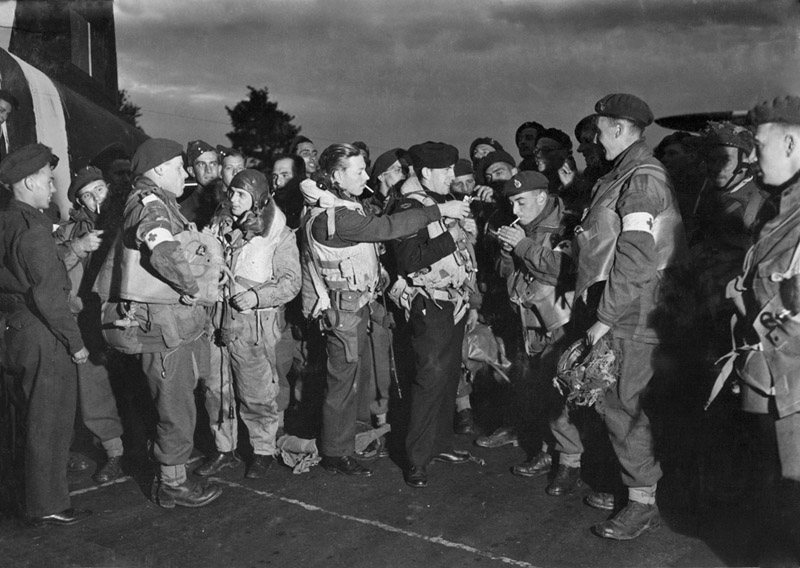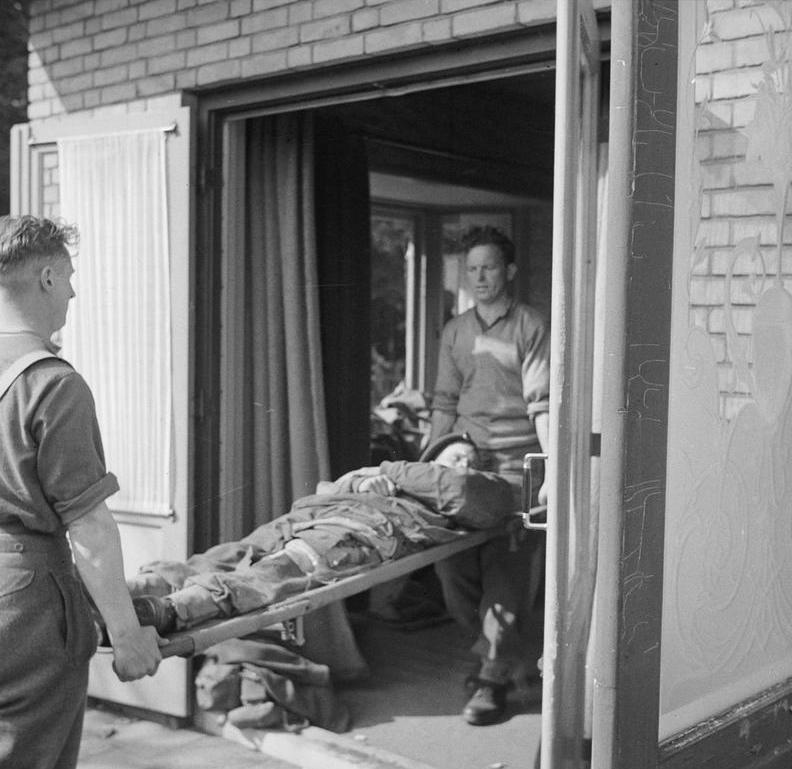|
195th (Airlanding) Field Ambulance
The 195th (Airlanding) Field Ambulance was a Royal Army Medical Corps unit of the British airborne forces during the Second World War. The 195th was the second airlanding Field Ambulance formed by the British Army. Once raised it was assigned to the 6th Airlanding Brigade, which was part of the 6th Airborne Division. It accompanied the brigade on operations, seeing service in the Normandy landings in 1944, and the River Rhine crossing in 1945, after which they remained in Germany following the advance until the end of the war. At the end of May 1945, the 195th was withdrawn back to England, but by the end of the year had moved with the 6th Airborne Division to the British mandate of Palestine in an internal security role. The 195th served in Palestine until the 6th Airlanding Brigade was disbanded. Background Impressed by the success of German airborne operations, during the Battle of France, the British Prime Minister, Winston Churchill, directed the War Office to investiga ... [...More Info...] [...Related Items...] OR: [Wikipedia] [Google] [Baidu] |
Cap Badge
A cap badge, also known as head badge or hat badge, is a badge worn on uniform headgear and distinguishes the wearer's nationality and/or organisation. The wearing of cap badges is a convention commonly found among military and police forces, as well as uniformed civilian groups such as the Boy Scouts, civil defence organisations, ambulance services (e.g. the St. John Ambulance Brigade), customs services, fire services etc. Cap badges are a modern form of heraldry and their design generally incorporates highly symbolic devices. Some badges that contain images of Lions or other cats are sometimes informally referred to as Cat Badges. Instances in military forces British armed forces The British Armed Forces utilise a variety of metal and cloth cap badges on their headdress, generally on caps and berets. They are also worn on Sikh turbans. British Army In the British Army (as well as other Commonwealth armies) each regiment and corps has its own cap badge. The cap badge ... [...More Info...] [...Related Items...] OR: [Wikipedia] [Google] [Baidu] |
Winston Churchill
Sir Winston Leonard Spencer Churchill (30 November 187424 January 1965) was a British statesman, soldier, and writer who served as Prime Minister of the United Kingdom twice, from 1940 to 1945 Winston Churchill in the Second World War, during the Second World War, and again from 1951 to 1955. Apart from two years between 1922 and 1924, he was a Member of Parliament (United Kingdom), Member of Parliament (MP) from 1900 to 1964 and represented a total of five UK Parliament constituency, constituencies. Ideologically an Economic liberalism, economic liberal and British Empire, imperialist, he was for most of his career a member of the Conservative Party (UK), Conservative Party, which he led from 1940 to 1955. He was a member of the Liberal Party (UK), Liberal Party from 1904 to 1924. Of mixed English and American parentage, Churchill was born in Oxfordshire to Spencer family, a wealthy, aristocratic family. He joined the British Army in 1895 and saw action in British Raj, Br ... [...More Info...] [...Related Items...] OR: [Wikipedia] [Google] [Baidu] |
Stretcher Equipped Jeep
A stretcher, gurney, litter, or pram is an apparatus used for moving patients who require medical care. A basic type (cot or litter) must be carried by two or more people. A wheeled stretcher (known as a gurney, trolley, bed or cart) is often equipped with variable height frames, wheels, tracks, or skids. Stretchers are primarily used in acute out-of-hospital care situations by emergency medical services (EMS), military, and search and rescue personnel. In medical forensics the right arm of a corpse is left hanging off the stretcher to let paramedics know it is not a wounded patient. They are also used to hold prisoners during lethal injections in the United States. History An early stretcher, likely made of wicker over a frame, appears in a manuscript from . Simple stretchers were common with militaries right through the middle of the 20th century. Gurney Generally spelled ''gurney'', but also ''guerney'' or ''girney''. The first usage of the term for a wheeled stretcher ... [...More Info...] [...Related Items...] OR: [Wikipedia] [Google] [Baidu] |
Maurice Anderson
Lieutenant-Colonel William Maurice E Anderson MD, DSO (often referred to as Bill Anderson despite the fact he went by the name of Maurice), joined the British 6th Airborne Division in 1943, and became CO of the 195th (Airlanding) Field Ambulance. (1)(4) Biography On D-Day he arrived at Ranville, France by glider and was wounded by sniper fire two days later at Longueval (2). He recovered (unlike the sniper, who was killed by a Royal Ulster Rifleman) and subsequently participated in the Ardennes offensive (the Battle of the Bulge) and Rhine crossings (Operation Varsity). In the latter operation his unit saw around 400 casualties during the 30 hours after landing. In 1945 he was part of the force that liberated Belsen and shook hands with the Russians on the banks of the River Elbe The Elbe (; cs, Labe ; nds, Ilv or ''Elv''; Upper and dsb, Łobjo) is one of the major rivers of Central Europe. It rises in the Giant Mountains of the northern Czech Republic before traversing ... [...More Info...] [...Related Items...] OR: [Wikipedia] [Google] [Baidu] |
Lieutenant-Colonel
Lieutenant colonel ( , ) is a rank of commissioned officers in the armies, most marine forces and some air forces of the world, above a major and below a colonel. Several police forces in the United States use the rank of lieutenant colonel. The rank of lieutenant colonel is often shortened to simply "colonel" in conversation and in unofficial correspondence. Sometimes, the term 'half-colonel' is used in casual conversation in the British Army. In the United States Air Force, the term 'light bird' or 'light bird colonel' (as opposed to a 'full bird colonel') is an acceptable casual reference to the rank but is never used directly towards the rank holder. A lieutenant colonel is typically in charge of a battalion or regiment in the army. The following articles deal with the rank of lieutenant colonel: * Lieutenant-colonel (Canada) * Lieutenant colonel (Eastern Europe) * Lieutenant colonel (Turkey) * Lieutenant colonel (Sri Lanka) * Lieutenant colonel (United Kingdom) * Lie ... [...More Info...] [...Related Items...] OR: [Wikipedia] [Google] [Baidu] |
225th (Parachute) Field Ambulance
The 225th (Parachute) Field Ambulance was a Royal Army Medical Corps unit of the British airborne forces during the Second World War. When raised the Field Ambulance was assigned to the 5th Parachute Brigade, which was part of the 6th Airborne Division. As such they participated in Operation Tonga, part of the Normandy landings. The unit remained in France until September 1944, when they were withdrawn back to England to rest and rebuild. They then took part in the last and largest airborne mission in the war, Operation Varsity, the River Rhine crossing in 1945. After the war in Europe ended they were sent to the Far East for operations against the Japanese however the war ended before they could be deployed. Instead they were sent to Malaya and Singapore to assist in the restoration of British control. Later in the year they were sent to Java, where the brigade had to maintain law and order until a Dutch force could arrive to relieve them. The Field Ambulance then returned to S ... [...More Info...] [...Related Items...] OR: [Wikipedia] [Google] [Baidu] |
224th (Parachute) Field Ambulance
The 224th (Parachute) Field Ambulance was a Royal Army Medical Corps unit of the British airborne forces during the Second World War. The 224th Field Ambulance was converted to an airborne unit in 1942, and assigned to the 3rd Parachute Brigade, part of the 6th Airborne Division. They first saw active service in 1944 during the invasion of Normandy, and remained in France until September. They were then withdrawn back to England only to return to the continent at the end of the year in response to the German surprise winter offensive in the Ardennes forest. Their final mission of the war was the airborne assault over the River Rhine in 1945. They remained in Germany until the final surrender in May that year. After the war the 224th remained with the 6th Airborne Division, and following a brief period in England were sent to Mandate Palestine on an internal security role. In 1948, the field ambulance and most of the division was disbanded. Background Impressed by the success ... [...More Info...] [...Related Items...] OR: [Wikipedia] [Google] [Baidu] |
133rd (Parachute) Field Ambulance
The 133rd (Parachute) Field Ambulance was a Royal Army Medical Corps unit of the British Army's airborne forces during the World War II, Second World War. The 133rd (Parachute) Field Ambulance was formed in Palestine in January 1943, by the conversion of the 133rd Field Ambulance to parachute duties. It was then assigned to the 4th Parachute Brigade (United Kingdom), 4th Parachute Brigade, part of the 1st Airborne Division (United Kingdom), 1st Airborne Division. As part of the 1st Airborne Division it took part in Operation Slapstick, part of the Allied invasion of Italy. The unit returned to England at the end of 1943, to prepare for their next mission. That was operation Market Garden in the Netherlands. During the following battle of Arnhem, the division was destroyed only 2,100 men returning from the 10,000 that had started the mission. Amongst the men who remained behind from the 133rd were those men not already captured during the battle, who choose to remain behind with the ... [...More Info...] [...Related Items...] OR: [Wikipedia] [Google] [Baidu] |

.jpg)



